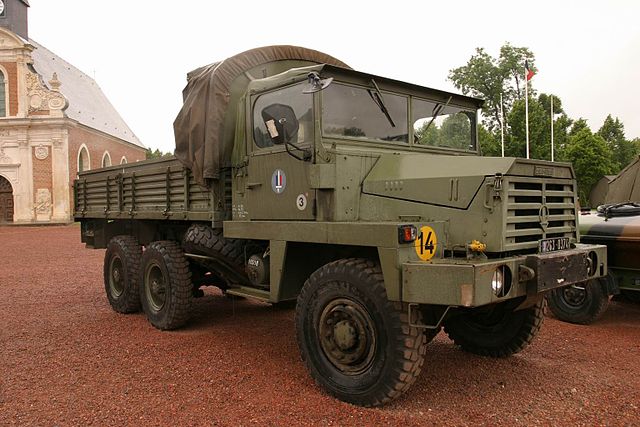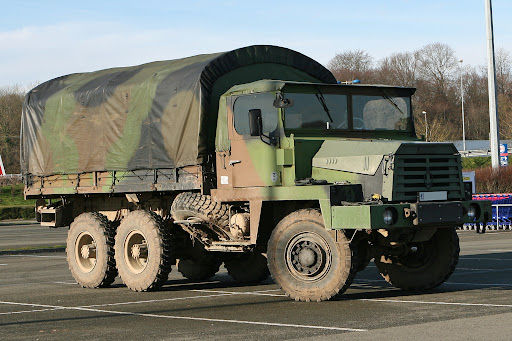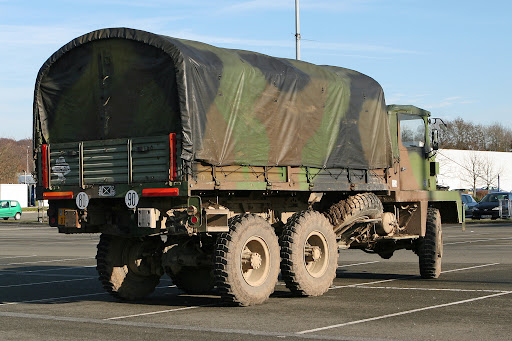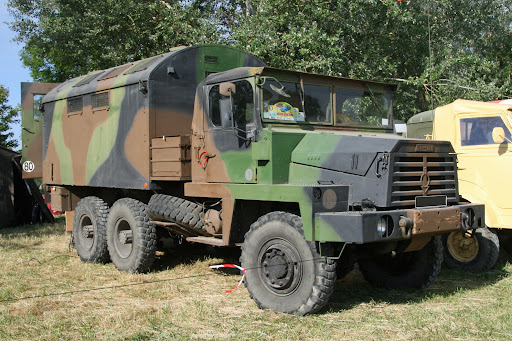Berliet GBC
 French army 6x6 tactical truck. 35,000 built 1961-75
French army 6x6 tactical truck. 35,000 built 1961-75
The Berliet GBC was developed in 1958 as a new type of all-terrain 6x6 truck aimed at the oil industry and desert conditions. For this was created the prototypes GBC Gazelle which took part in an expedition, the "Missions Berliet-Tenere". The success proved the type was indeed well suited, and the Army, which had a specification to replace the venerable WW2 GMC CCKW and wanted a model fit for the conditions in Algeria, ordered it. The military variant was done to NATO standards of the time as the GBC 8 TK. 35,000 in all variants were delivered to the French Army, making the bulk of its cold war troop and supply transportation assets until the 1990s. The last were still modernized to extend their sevrice life for another decade. It was also licence built in China and Portugal (As the Tramagal).
About Berliet
Berliet was a French manufacturer of automobiles, buses, trucks, and military vehicles. The company was founded in 1899 by Marius Berliet and was based in Lyon, France. Berliet became well-known for its commercial vehicles, particularly trucks and buses, which were widely used across France and exported to various countries. Throughout its history, Berliet was involved in various collaborations and mergers with other automotive companies. In 1967, it merged with Citroën to form Citroën-Berliet. Later on, it became part of the PSA Group (Peugeot Société Anonyme) in the 1970s.
Berliet's legacy in the automotive industry includes innovations in diesel engine technology, particularly for heavy-duty vehicles. The company also had a significant presence in military vehicle production, supplying trucks and other vehicles to various armed forces. Although the Berliet brand itself ceased to exist after its integration into larger automotive groups, its contributions to the French automotive industry and its role in commercial vehicle manufacturing are still remembered today.
Berliet military trucks were an important part of the French Military. The first was the pre-WW1 Berliet CBA, replaced by the GD series. In 1939, Regular passenger car production ceased for trucks only, and postwar buses. The main military truck produced at that stage was the Berliet VDCA, a 4x4 long wheelbase model. When captured, some 20 brand-new sedans ended in German hands and the factory was forcibly returned to service, however the attempt was short-lived notably due missing workers and hidden machine tools. It was not the case for the factory in Lyon, which manufactured 2,330 trucks for the Germans. After the liberation, 50 sedans were assembled and in 1946 the company under Marius Berliet's son Paul created the GLR truck as its first new post-war vehicle.
1957 saw Berliet unveiling the T100 6X6 with a 600 PS (441 kW; 592 hp) or 700 PS (515 kW; 690 hp) with a Cummins V12 engine giant truck, trumpeted as worlds's largest. The 6X6 Roadtractor was used in North Africa, notably by petroleum companies in the desert. But this hand made model made in Courbevoie (Paris) was joined by three others in 1958-1959 which remained record-holders but were too extreme for production. Berliet later purchased MOL Trucks of Hooglede, Belgium and started its own MOL model range (4X4, 6X6 and 8X8 lorries, tractors).
The Berliet GDR 1936 became for example a famous model used by the Military, thanks to its long chassis, heavy payload, and large engine range, including coal-burning "gazogene". In 1946 the GDR was relaunched with a 7 tonnes payload, with a 180 monthly delivery and in 1948 the innovative GDR 7W, with 1,800 made this year alone, more than one third of the company's income. The army used the tractor as tank transporter and the air force to ferry plane parts, including whole fuselages. Meanwhile, the massive T100 was caught by the Berliet GBO15, as super-heavy duty production model, still mostly used by the petroleum industry. But the 1960s would be marked by the GBC, later replaced by the TBU. As tank transporter, the GBH became a favourite as well and the TF was the last of the brand for Military purposes.
Development

Early GBC Gazelle/TK Prototype in Africa
Berliet was made famous for heavy duty trucks usable in difficult conditions and started to make a truck specially designed for the extreme desert, with good resistance to temperature differences as well as sand and dust. This endeavour was named the "Missions Berliet-Tenere". These were two trans-Sahara expeditions organised by Berliet which demonstrated the ability to cross long stretches of desert and wilderness but for scientific purpose at the time by supporting geographical and scientific research. Departing from Djanet in Algeria towards Fort-Lamy (today N'Djamena, Chad) they arrived on January 7, 1960 under the direction of Commander Armand. Despite pessimism of some it appear that well designed truck could well be ideal transportation methods for exploring deep desert. On this base was established the GBC 8 "gazelles" (an african antelope). They were capable to maintain a constant speed on the most difficult road conditions.
The GBC 8 KT was developed from a wealth of information gathered during the Ténéré mission, and the already designed Berliet GBC was impràved across the board with a refined 6x6 chassis. The acronym was composed as previous ones in the brand's manufacturing practices, "B" sanding for 3 axles, "8" for the 8 liters displacement of the engine, "6" for 6 drive wheels. The new truck was trialled agains after some modifications and soon attracted the attention of army for its Saharan units, since France at the time was still in Algeria.
Berliet GBC 8 KT 6x6 was thus the definitive army model, "K" standing for multi-fuel engine, and "T" for tactical. This new military truck was derived from the "gazelle" but it had a new torpedo cabin (meaning with non-rigid roof and folding windshield) as well as angular lines designed by Berliet's in house designer Charbonneaux. From 1962, the GBC 8 KT was delivered to the French army and started its long duty over 30 years. Indeed it's only by 1993 that the DGA (French Procurement Office) decided to modernize these trucks converted as the "GBC 180" in newly created Limoges workshops, at a time Berliet as a bran was long gone, it's legacy surviving through Renault Trucks.
Design of the Berlier GBC 8 KT
 1970s GBC 8 TK model with its standard livery, partially open tarp, Berliet Villa coll. (cc)
1970s GBC 8 TK model with its standard livery, partially open tarp, Berliet Villa coll. (cc)
Appearance
The GBC had a 6x6 ladder style chassis with twin rear wheels, single on forward axles, and the general outlook was very angular. This was on purpose, for manufacturing facility and at a lower cost, but also stylized as NATO preconized. The "torpedo" configuration was also purely a NATO military standard for 6x6 trucks, alongside the multifuel engine. Thus, the Berliet GBC 8 TK was to have a flat folding windshield, open doors with optional platic later, and a framed tarpaulin cover for the roof strapped on a rear bow. Berliet however made the forward attachement point for the flexible roof further forward in order to keep the sun glare away from the windshield and desert conditions. The simple squared windshield had top mounted gravity wipers.
Dimensions wise, little info is available in French, but at least data is certain about the GBC Tramagal 8KT CLD which is used as base here: 7.28M long overall, for a Width of 2.4 meters and an overall height of 2.7 meters. Empty weight is 8000kg. standard flatbed Capacity 5,000kg.
The initial Berliet GBC TK prototype had a very simple bonnet, with a sloped downards top, two folding outwards access panels, and flat sides. Later it was revised in a more complex way, with a new slanted half-faces profile down to the lower part of the engine cradle. If the radiator grille did not changed much, only made wider, the side bonnet luvres were deleted for six smaller ones (rain proof) located on the upper section of the bonnet.
The Torpedo cabin sat on a platform-like rectangular section cut out where the bonnet started forward and a second "step" with prismatic, but bulky bumber was located, integrating the headlights and hooks, plus the cache for an option winch. The prototype had two sets of lights either side of the upper platform, which was thinner and acted as mudgards for the forward axle. Behind the roadhweel and underneath this platform was located a step to access the cab. There were simple shapred bar steps also welded on the extremity of the bumper to access the cab from the front, another feature that was popular.
Generally a spare roadwheel was installed on the left side unde the chassis behind the cab, and the main fuel tank on the right side. This was swapped however on some models, as well as the location of the oil tank. After the twin rear axle were located, also under the chassis's tail, two utility tolboxes and standard tailk lights on the back plate. Like all standard supply/troop trucks of the day, the GBC 8 TK had a generous flatbed, framed by folding all metal sides and a folding upper back plate for access. The flatbed could be covered by a synthetic waterproof tarpaulin enclosed on both ends, fixed on five bows. They were stored forward when not in use.
Engine and Performances
The GTB was of course powered by the in-house Berliet Magic MK520, which was a 5-cylinder in line, multifuel (French "polycarburant") in order to run on gasoline, gasoil, alcool, or aviation high octane kerosen. It had a capcity of 7,9 L and was rated for 125-135 hp at 2100 rate per min. with a torque of 345 Nm à 1800 tr/min. It procured a top speed on road of 82 km/h, 80 kph being more common when fully loaded and c35 kph off-road. Thanls to a left size fuel tank of 95 liters max range on road is 563Km.
The 6x6 transmission went through a 6 speed with planetary transfer case. Rear differential lock with four speeds on the rear wheels to pull simultaneously, at 100% torque. Not amphibious since it had no buoyancy, the GBC 8 was still able to ford up to 1,20 to 1,50 meters of water but it lacked snorkel like exhausts like on the M35. Its total weight with payload was up to 12 tonnes, with a useful flatbed and towed load of 4 tonnes each and capacity to tow the Titan Army trailer of 6 Tonnes. The GTB was also declined into a long wheelbase (no info yet) and tractor variant, also in 6x6.
Reception and service

The GBC 8 TK was at the origin a private venture by Berliet but ended as the most desirable option when the Army in 1959 specified a requirement open to all truks manufacturers in France for a replacement for its GMC CCKW fleet inherited from WW2 Free French service and postwar surplus acquisition. Some, in addition to WW2 had soldiered in Indochina, and in Algeria as well, and were pretty worn out. With its massive production over the years, the chosen Berliet GBC managed to perfectly match NATO guidelines for mil. trucks standards as well as replacing for good the CCKW in French service, which eneded in the scrapyard or in private collections.
While in service with the French Army after its introduciton in 1961, the GBC was propularly called by the grunts « Bébert » (an affectionate diminutive of Bernard, which was close to "berliet"). These ferried tens of thousands of soldiers, mostly consripts between 1961 and 1975 with some 35,000 built until the brand was absorbed and production swapped on the TF. Its first deployment was in Algeria, seeing the last year of a dirty war. This was a trusted, mythical, extra-reliable beast of burden of the cold war
Armée Française both as main troop and supply transporter.
It saw action in many external operations, notably still soldiering in Africa in the 1980s. The Berliet TF was not a replacement but a complement in service. it was a more extreme 8x8 tractor truck with cab over engine use to carry standard 38 ton payloads, boats, bridges and other heavy equipments. But the main tactical truck remained the GBC all the way to the end of the cold war. Today the French Army works with Renault Trucks and ACMAT lighter lorries, especially popular in Africa. The latter with their angular shapes are clearly recalling the years of the "Bebert".
The GTB was famously exported and then licenc-built in Portugal as the "Tramagal" and in China. There are conflicting figures for production some sources stating 19,000 trucks were manufactured, but it's probably a sub-variant (such as the
long wheelbase). On of these "old buggers", 1971 vintage, was purchased by Marvel Studios, repainted in a menacing night blue livery and shot in "Captain America- The First Avenger". Many are still around in private collections or still in use in civilian services, notably forestry and industries.





Src/Read More
All military Berliets 1914-1940 by F. Vauvillier, L. Lecocq 2019
lautomobileancienne.com
fr.wikipedia.org GBC8 6x6 Gazelle
3emegroupedetransport.com
Berliet foundation
arquus-defense.com
tanknutdave.com
militarytoday.com
fondationberliet.org
maquetland.com
encyclautomobile.fr
archive.wikiwix.com
fondationberliet.org
commons.wikimedia.org
On rouillac.com
On milinfo.org
On facebook.com
genieminiature.com
berlietpassion.over-blog.com
encyclautomobile.fr
All Berliet trucks video over 125 years up to Renault
Berliet History (FR)
Full workaround and expert explanation video (FR)